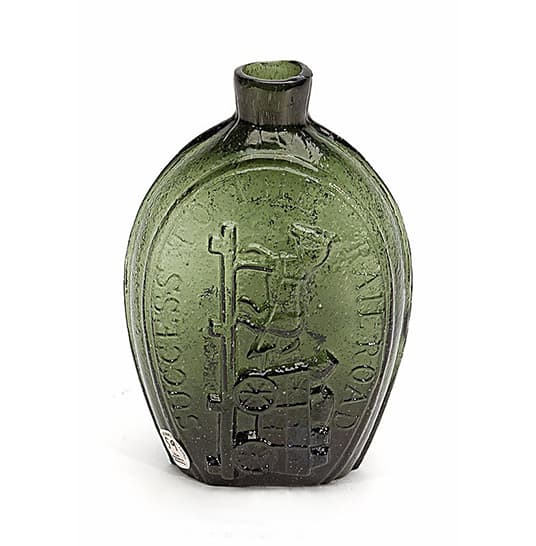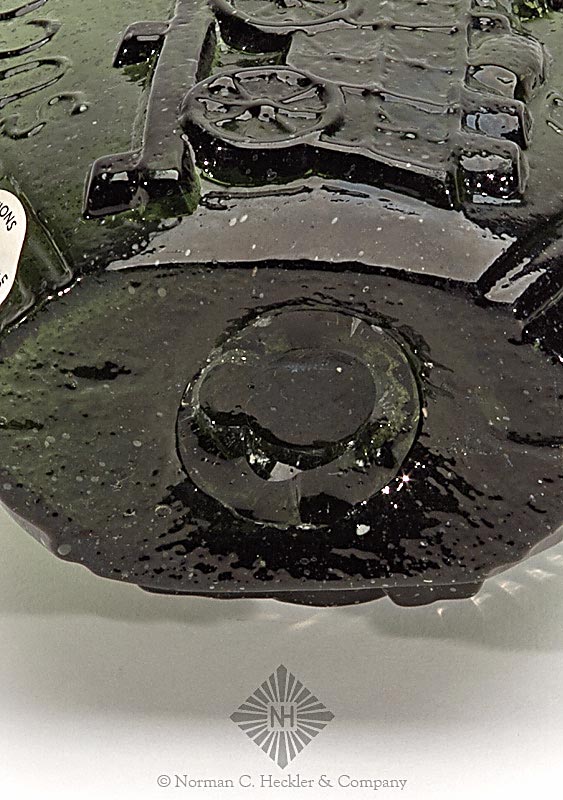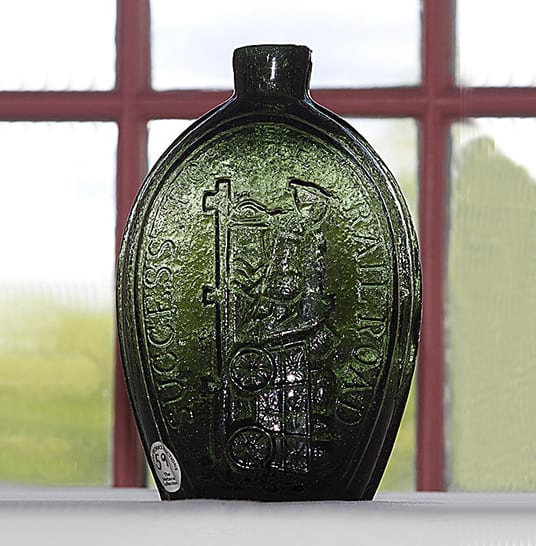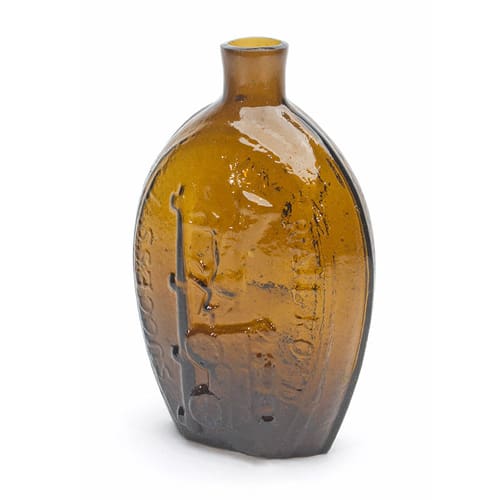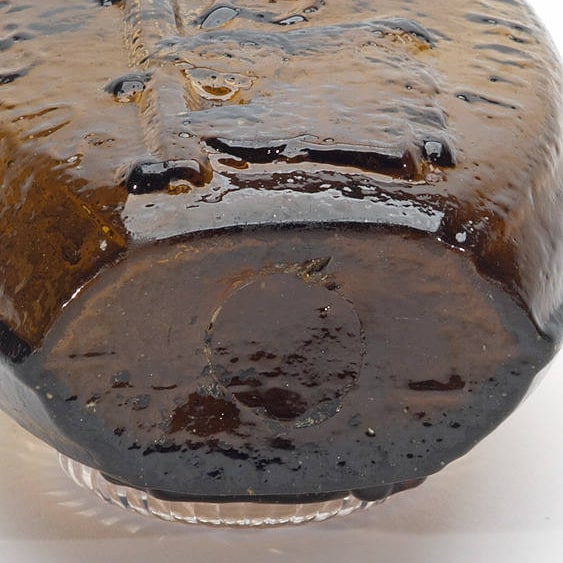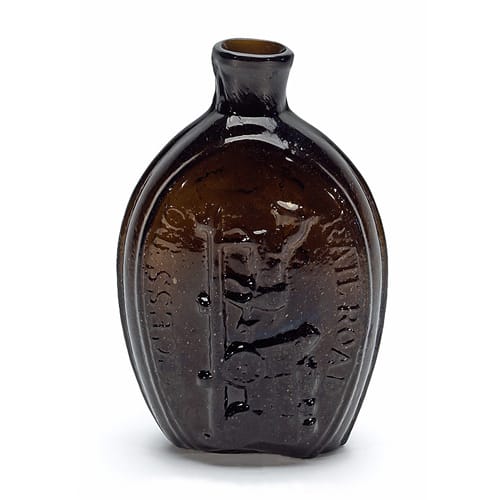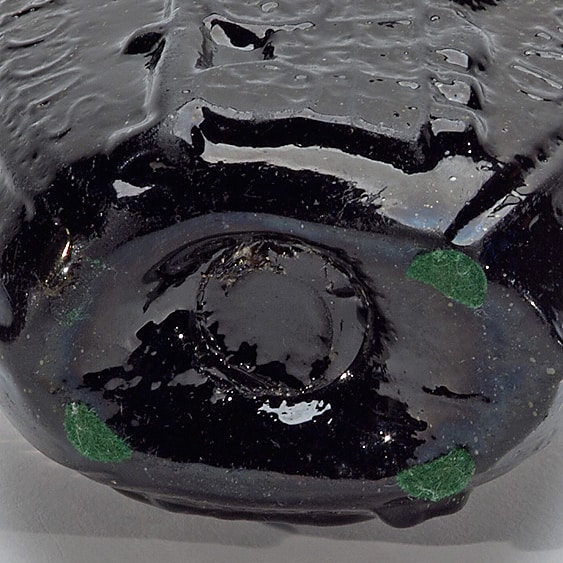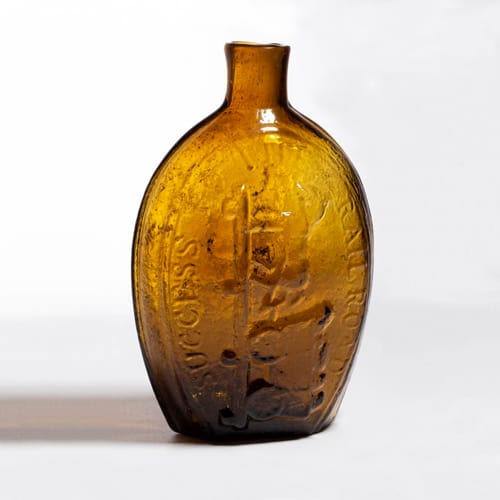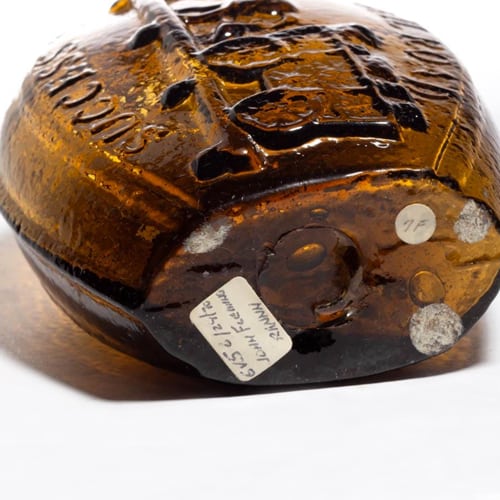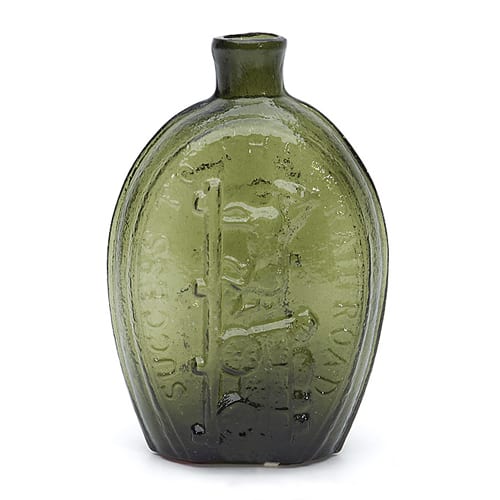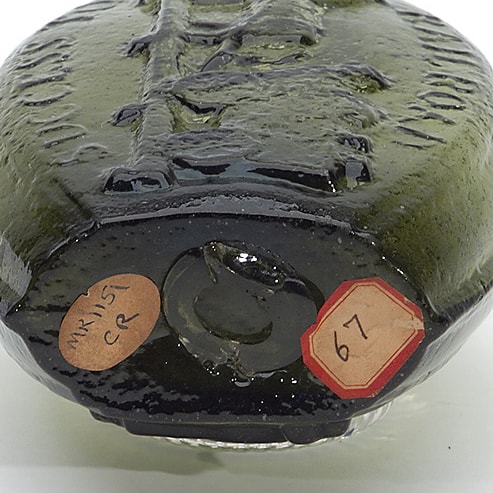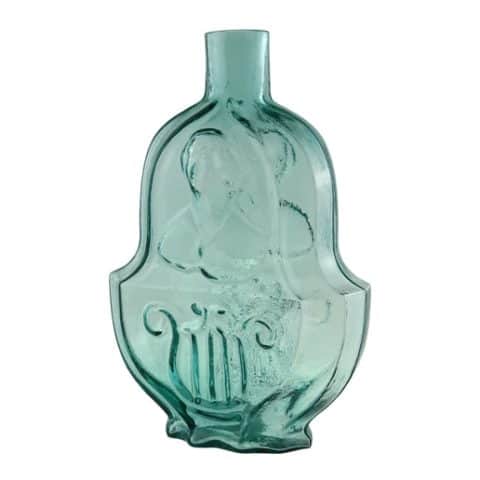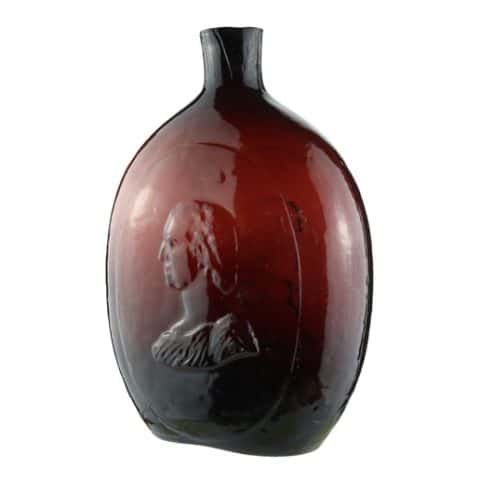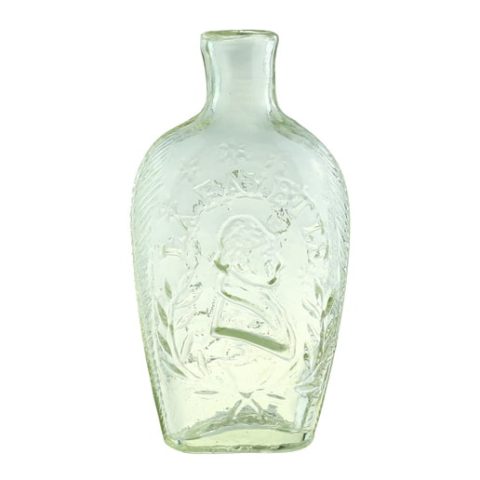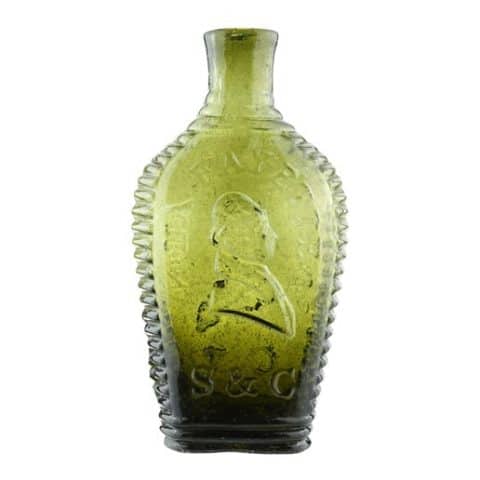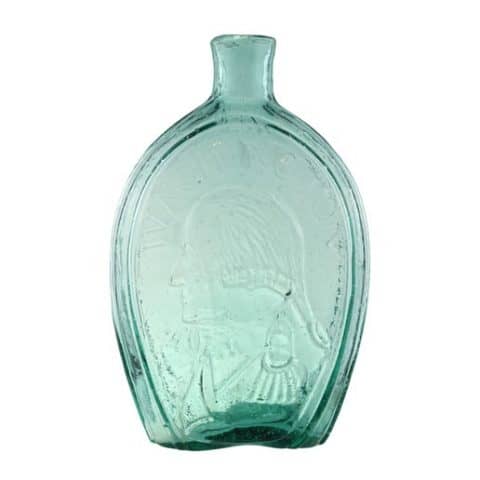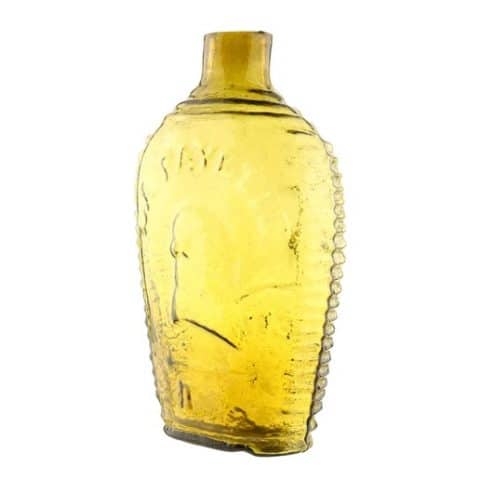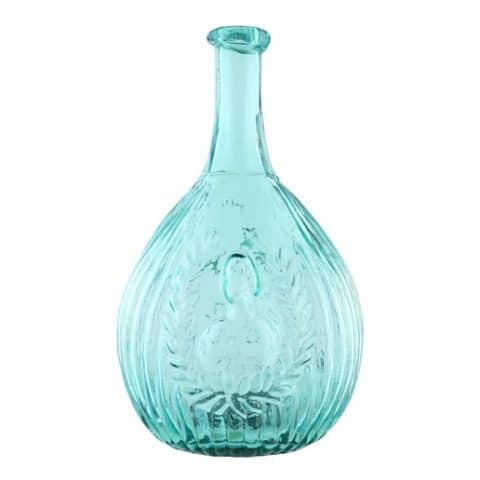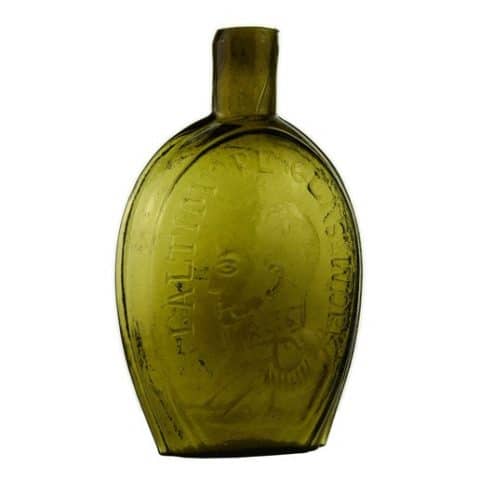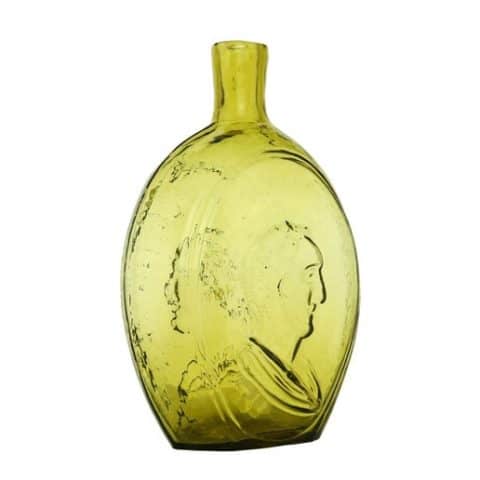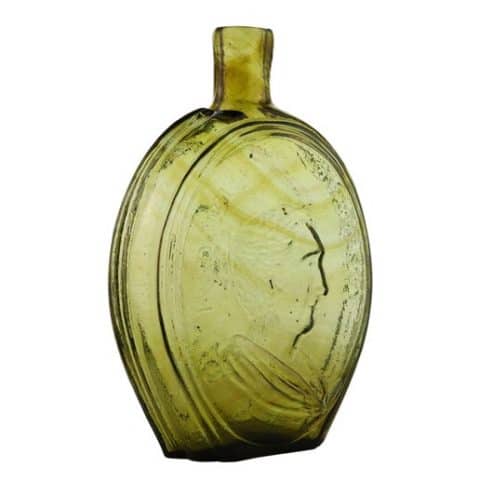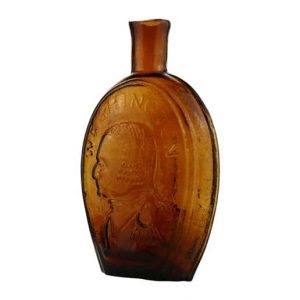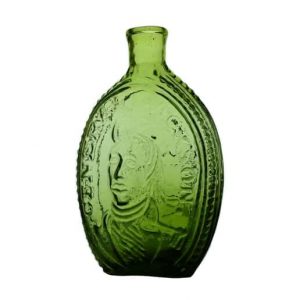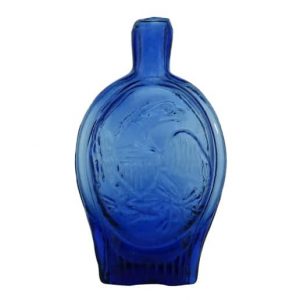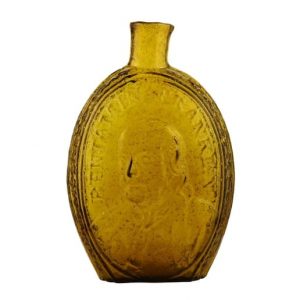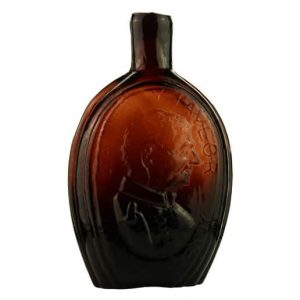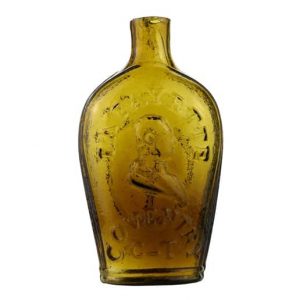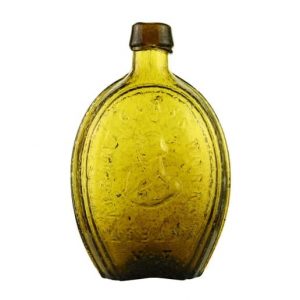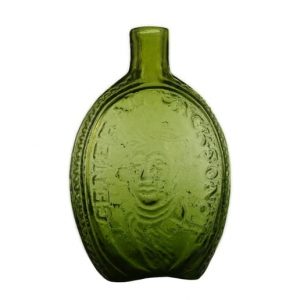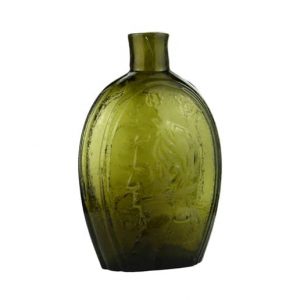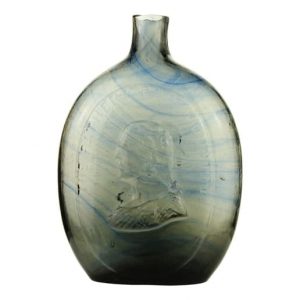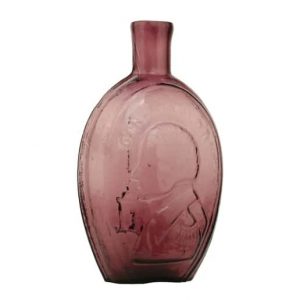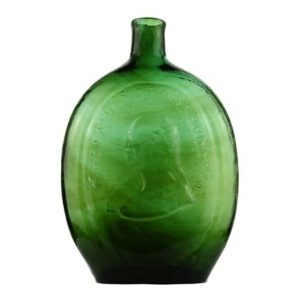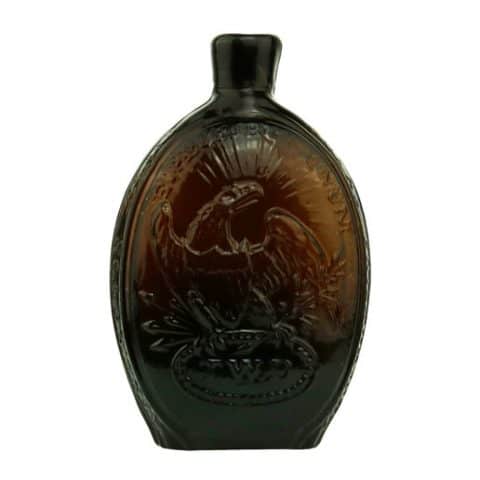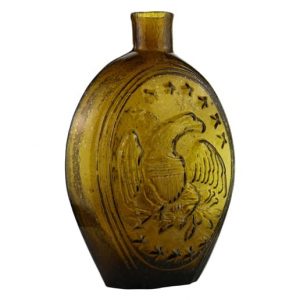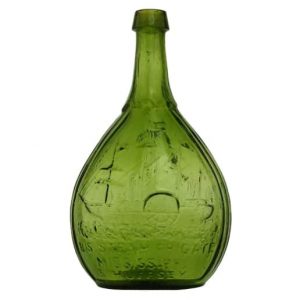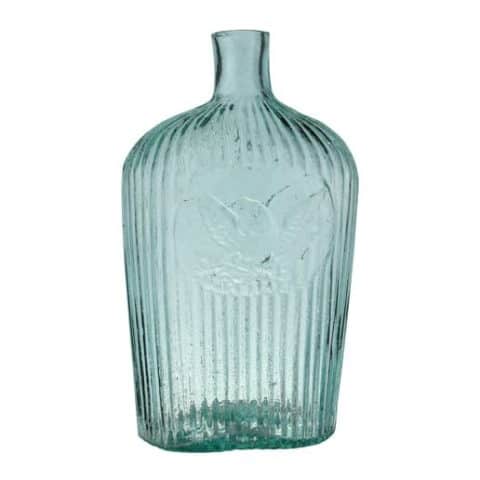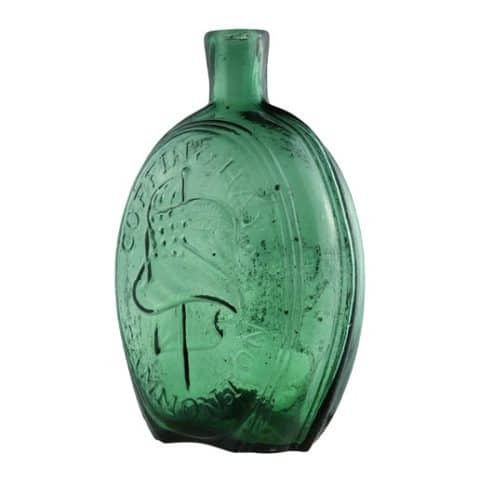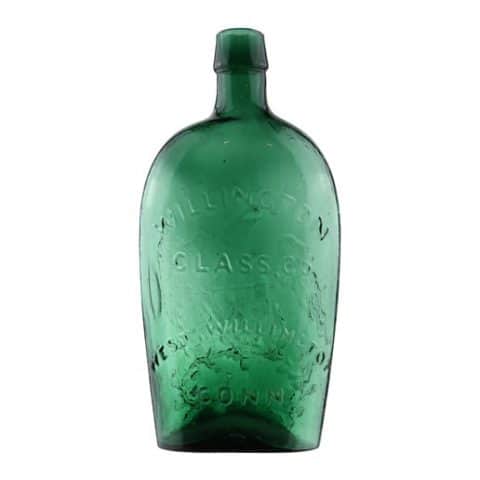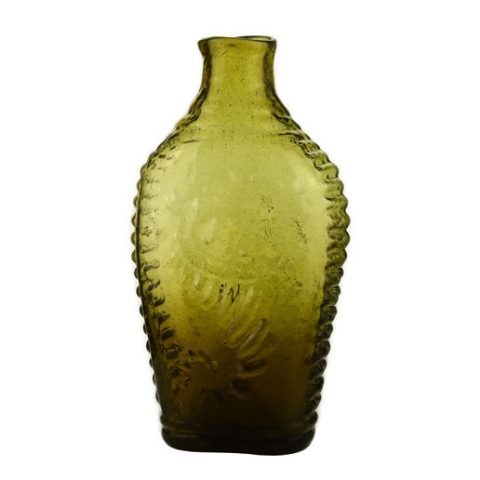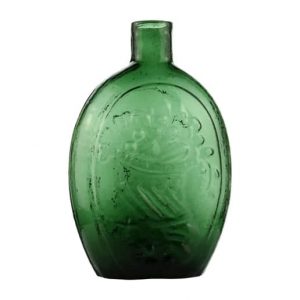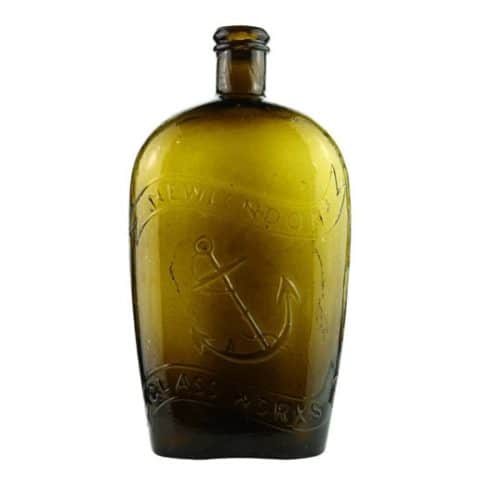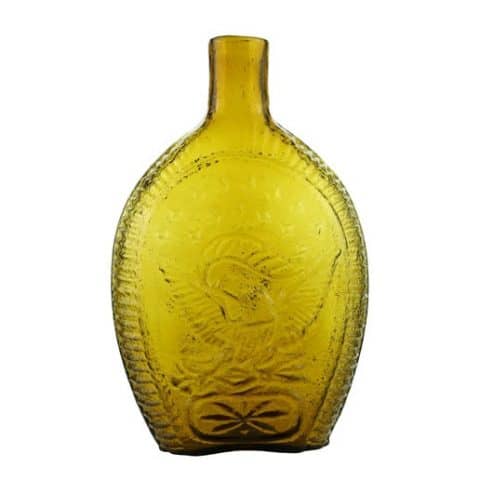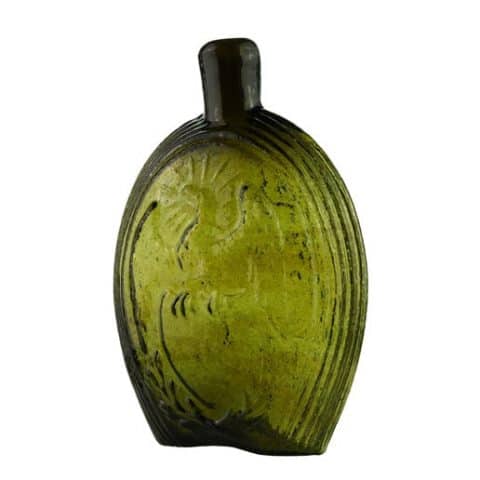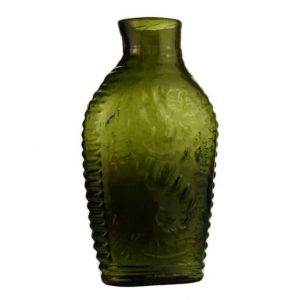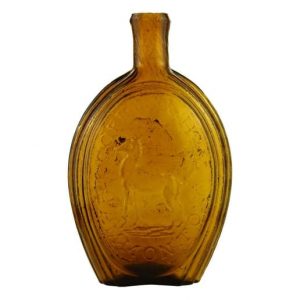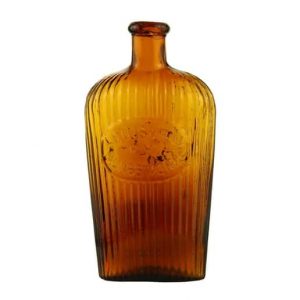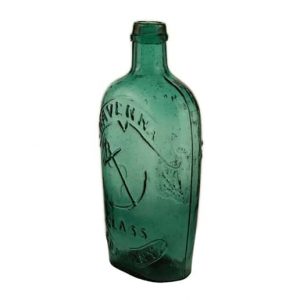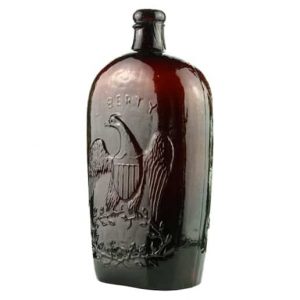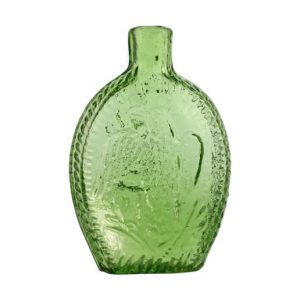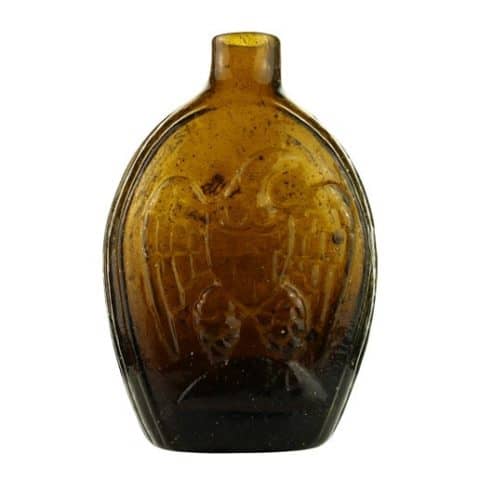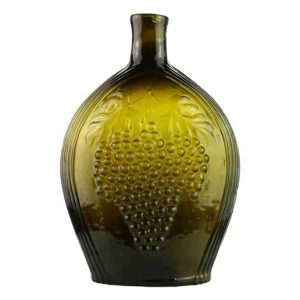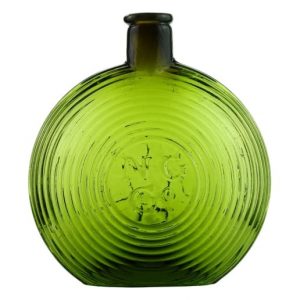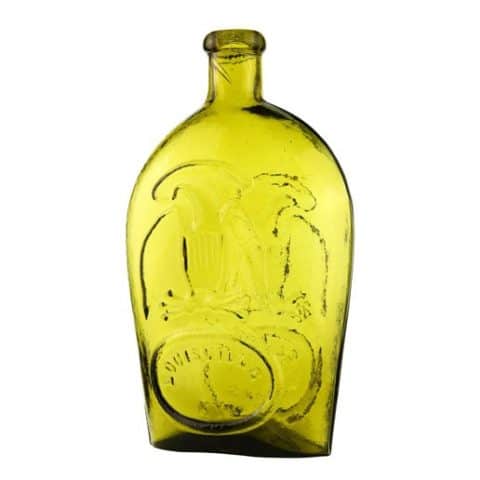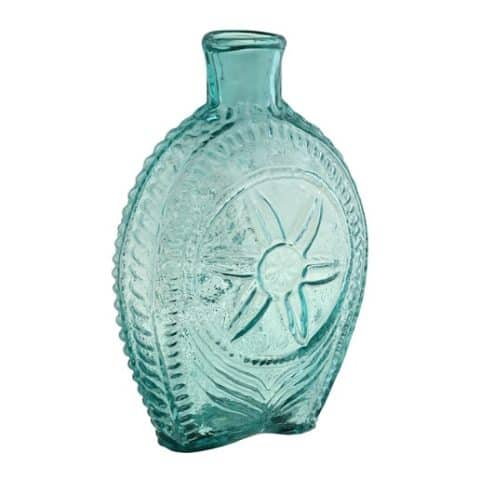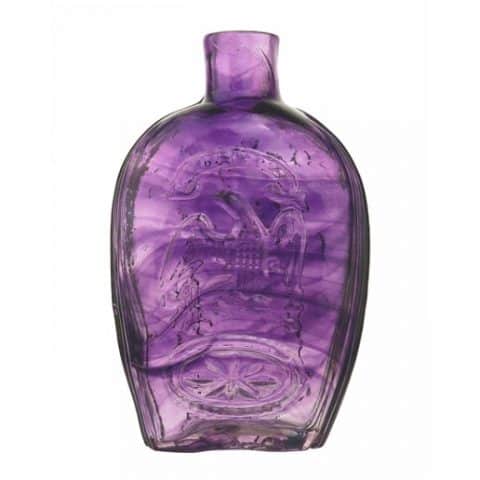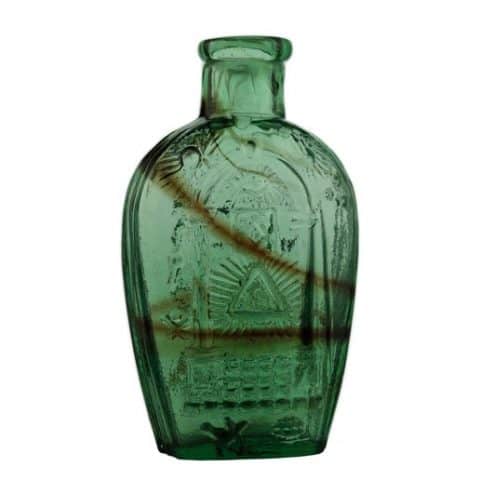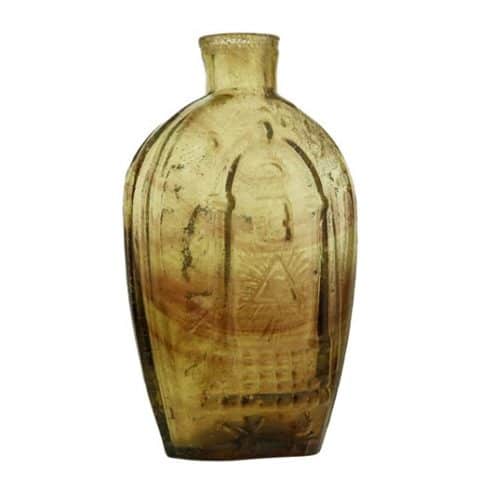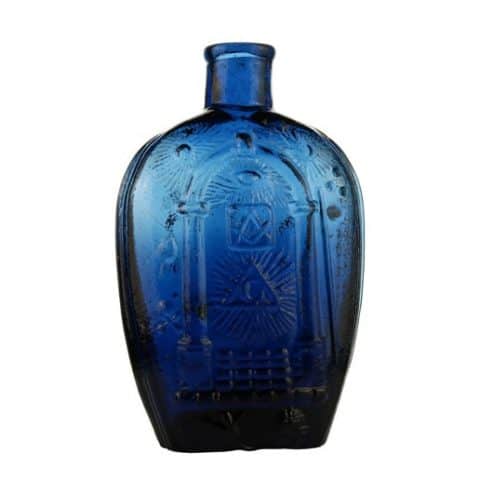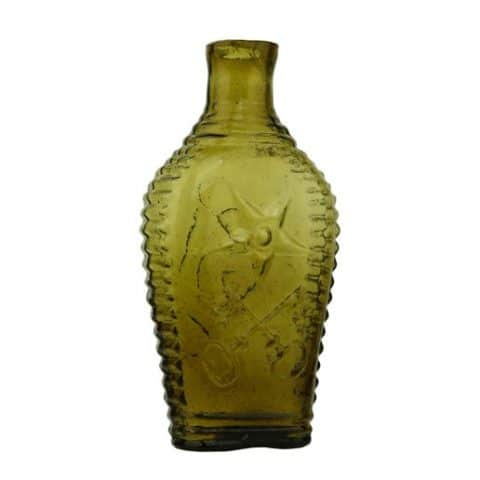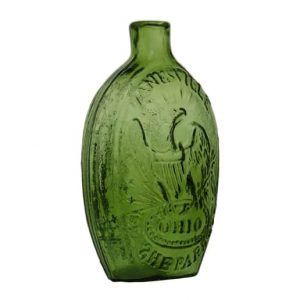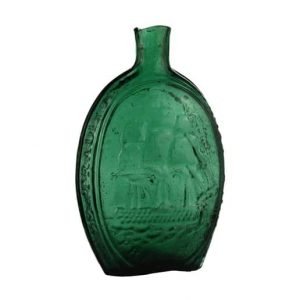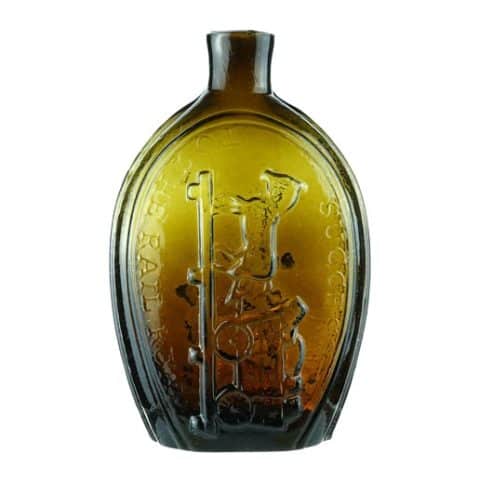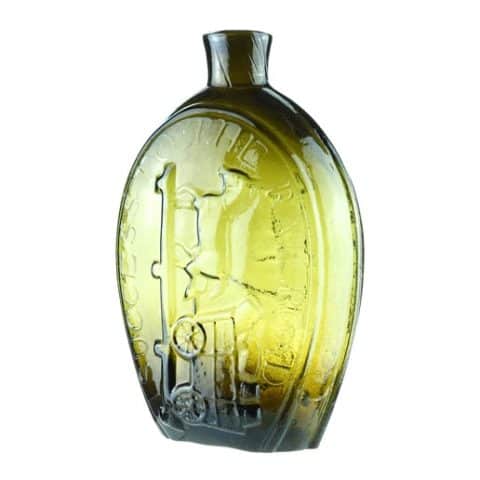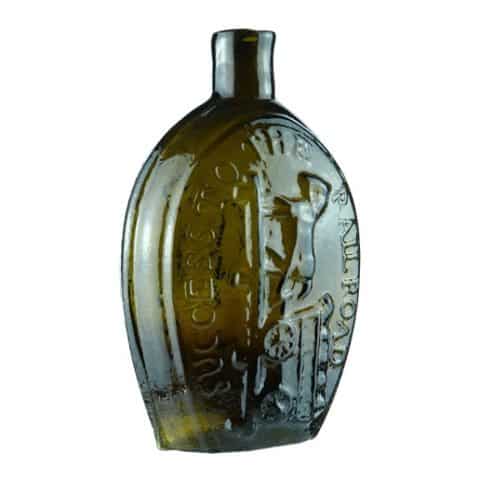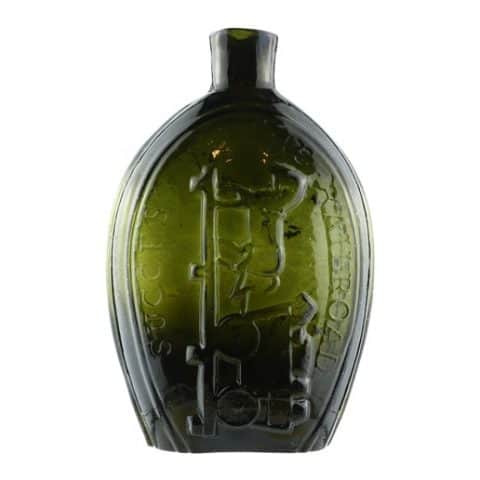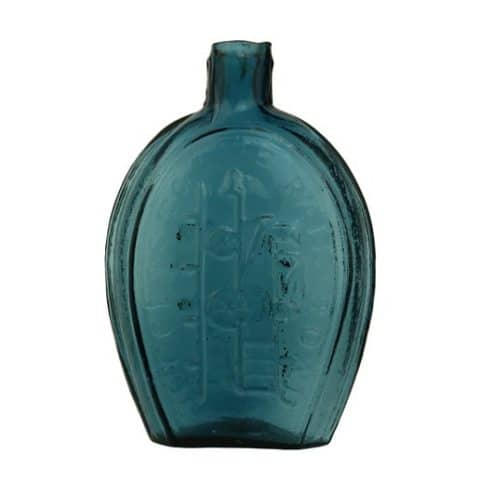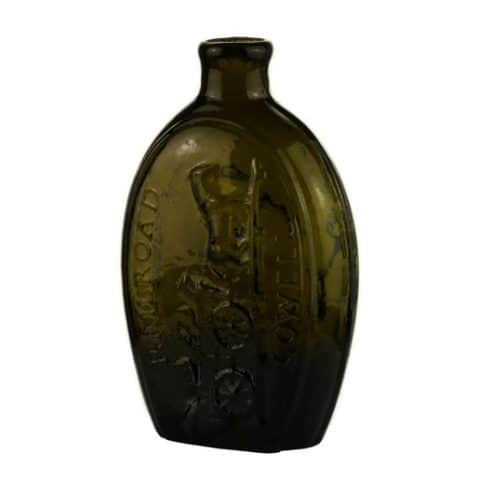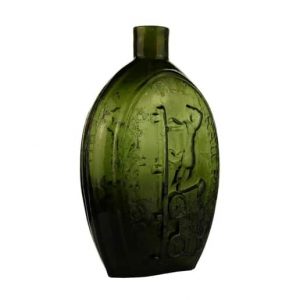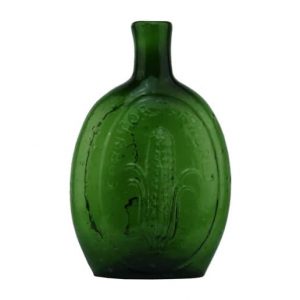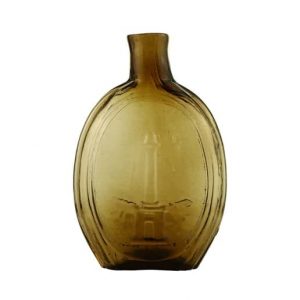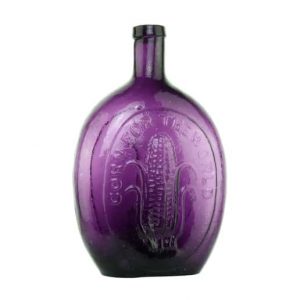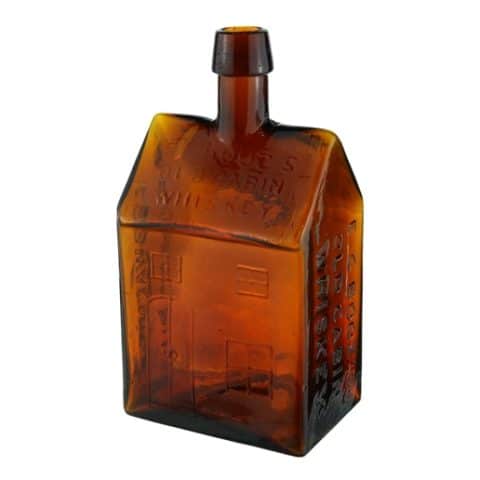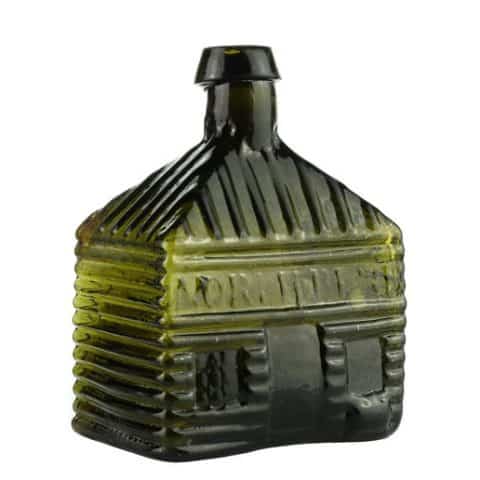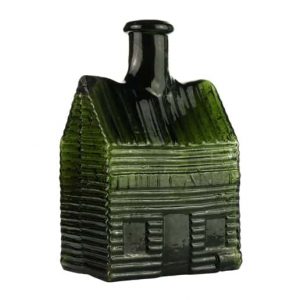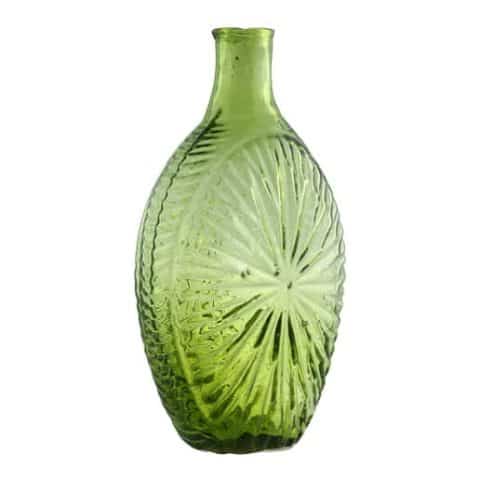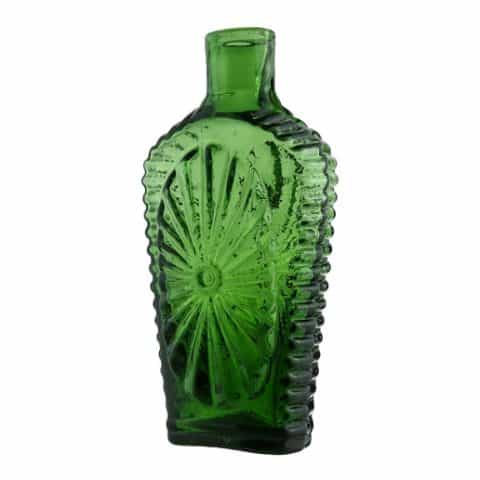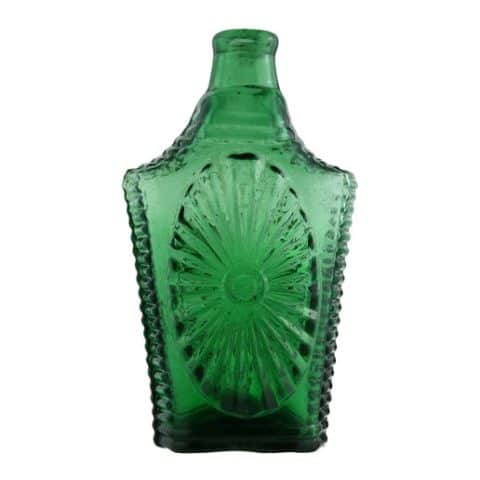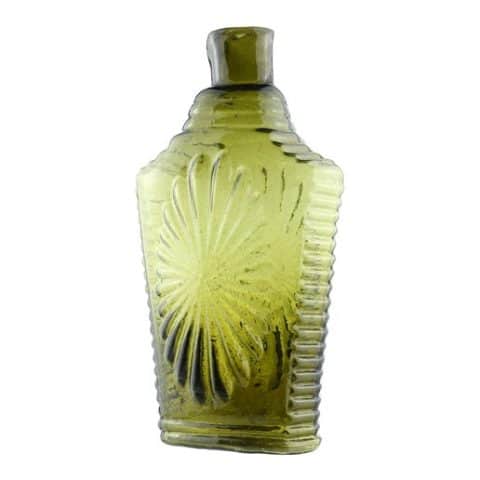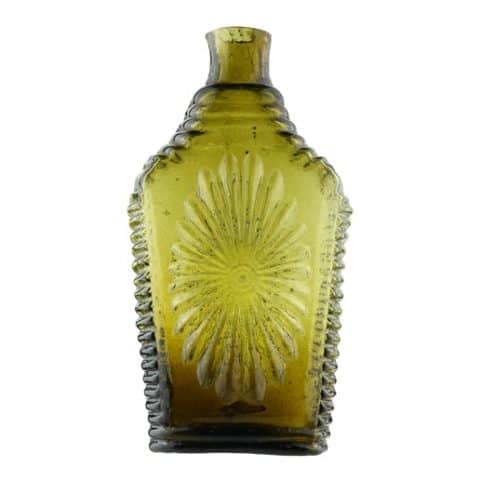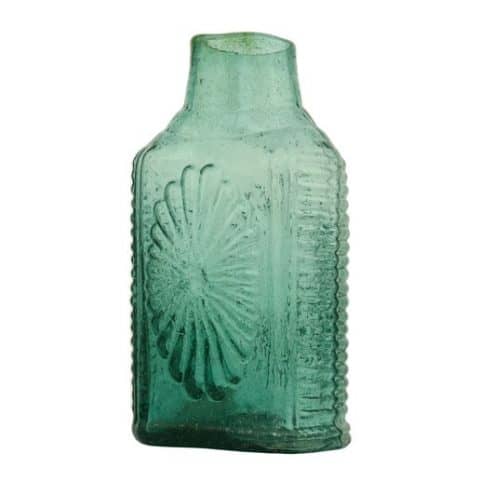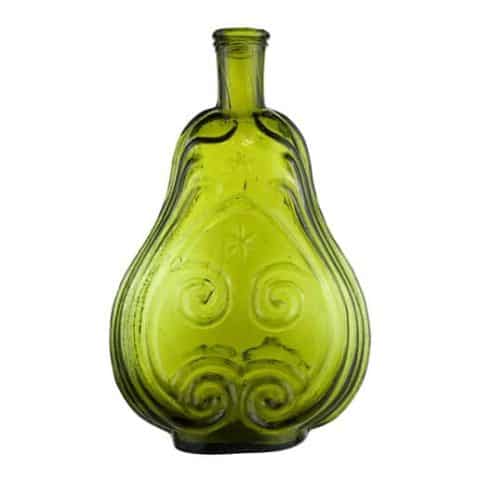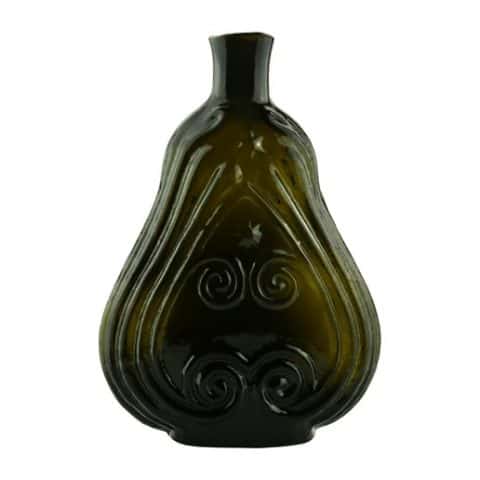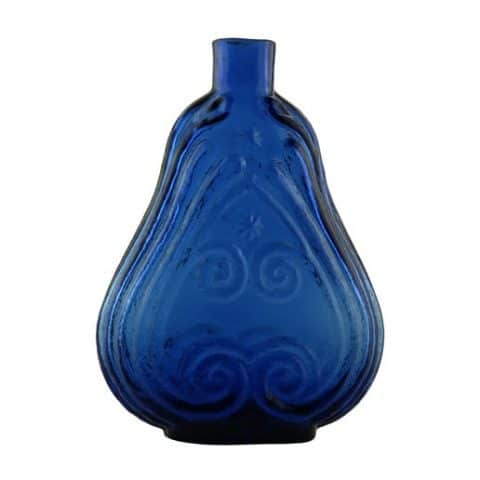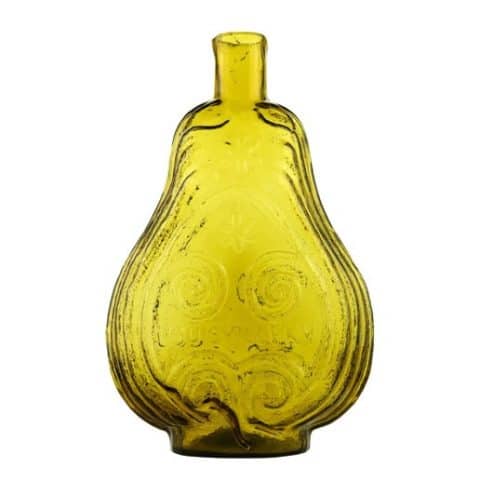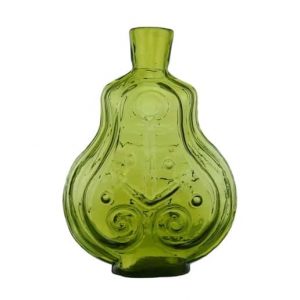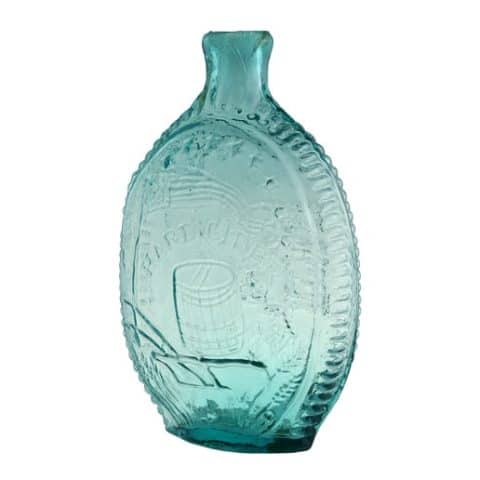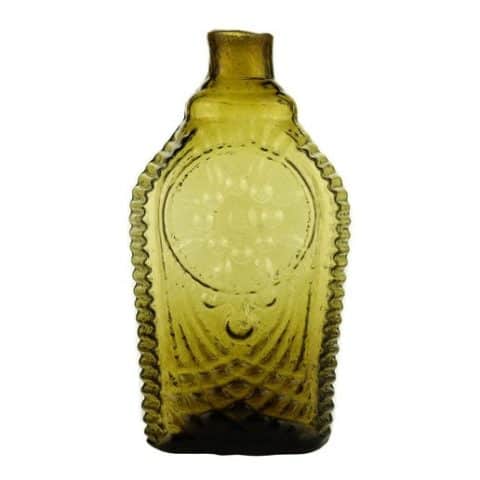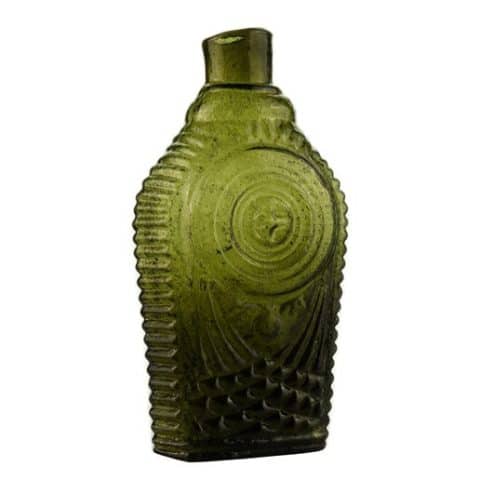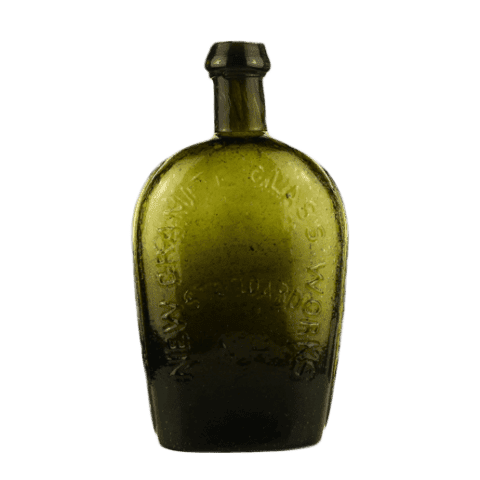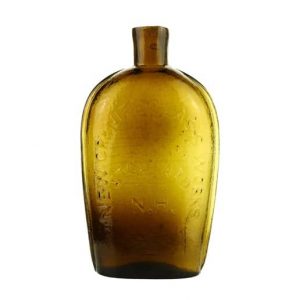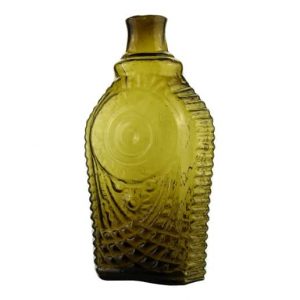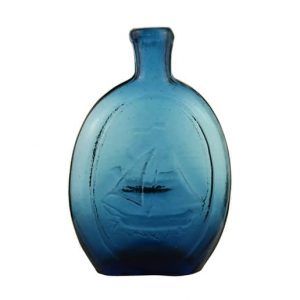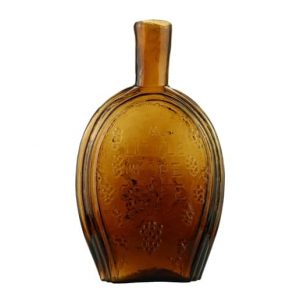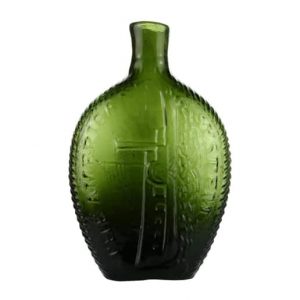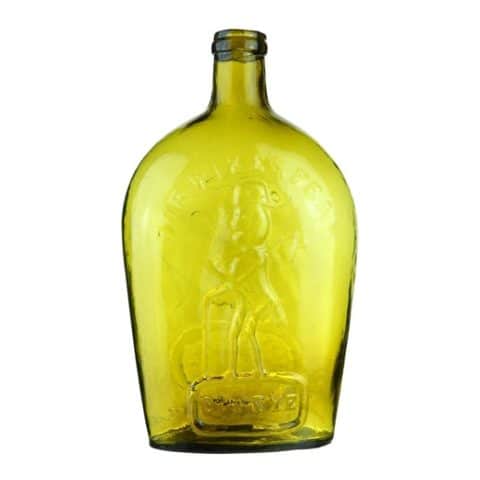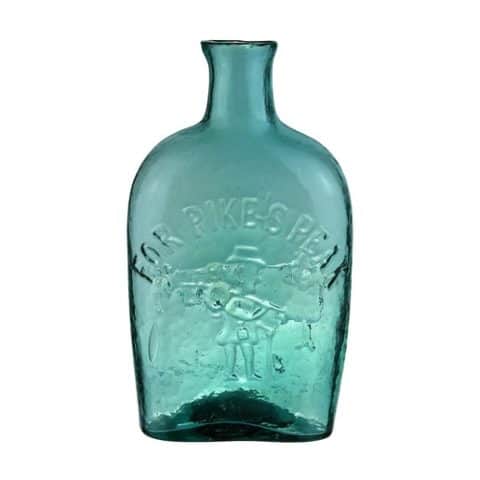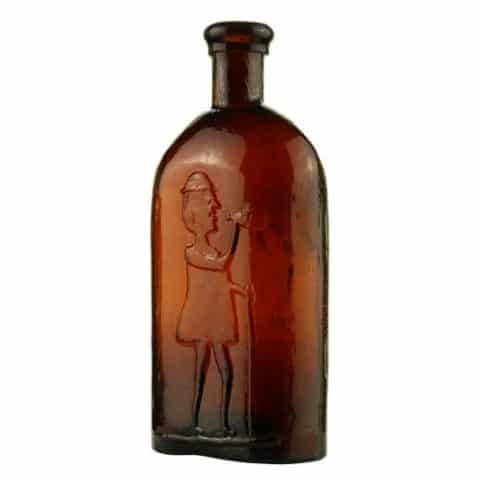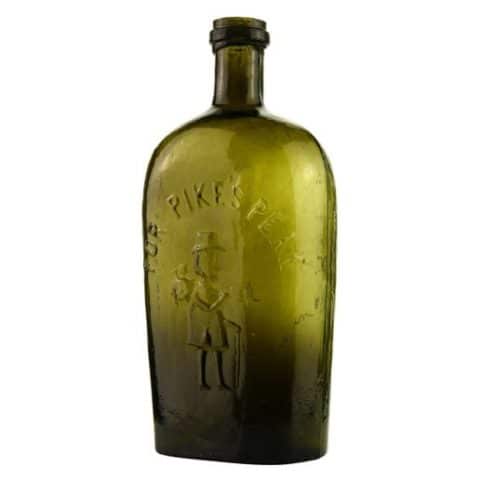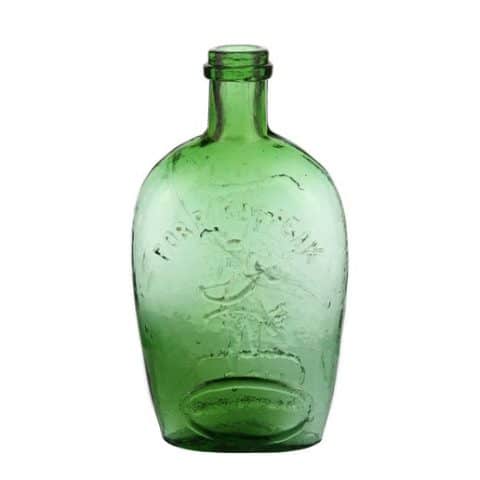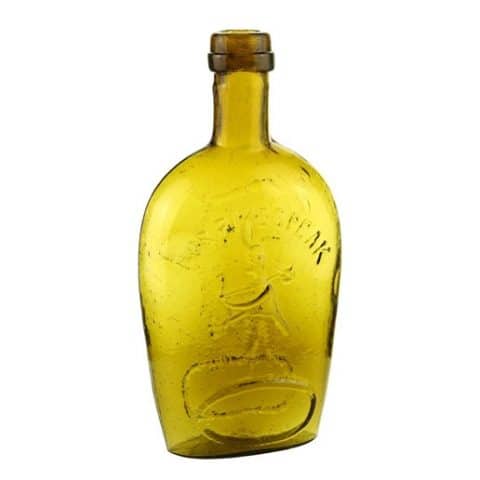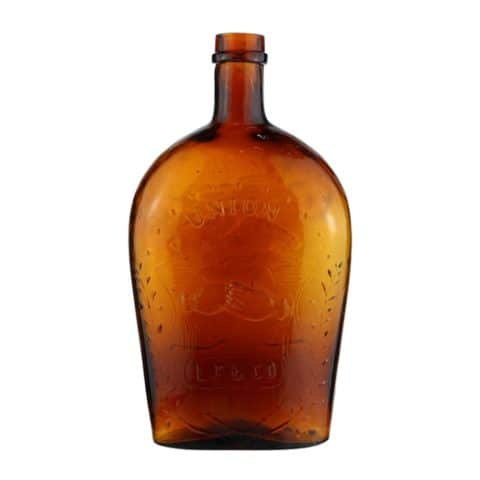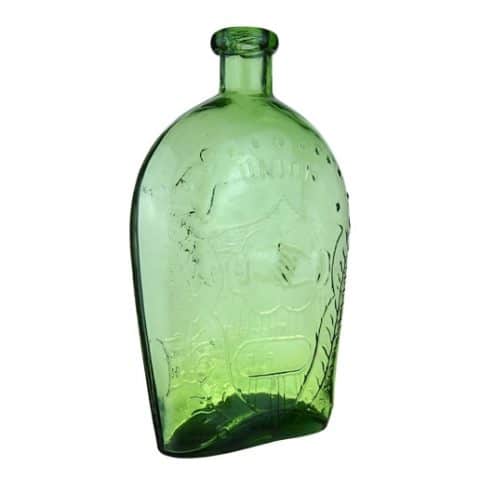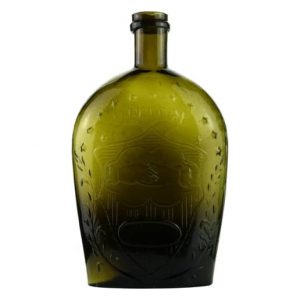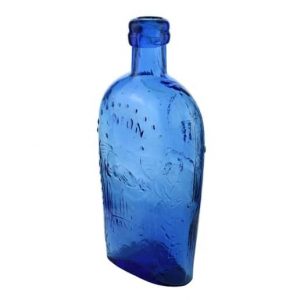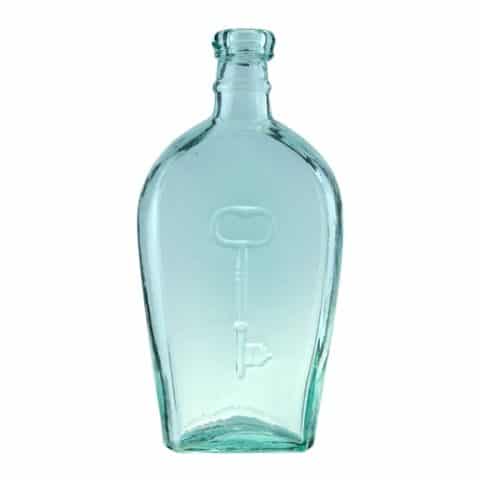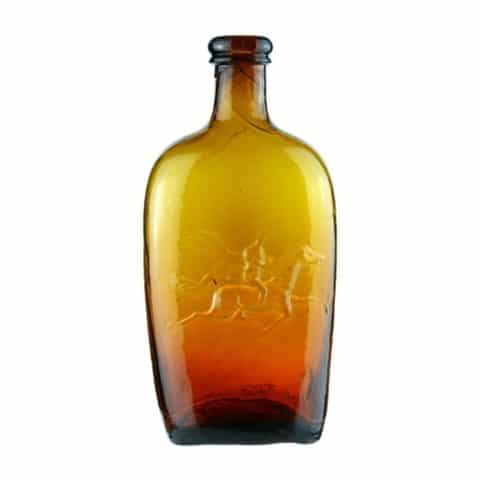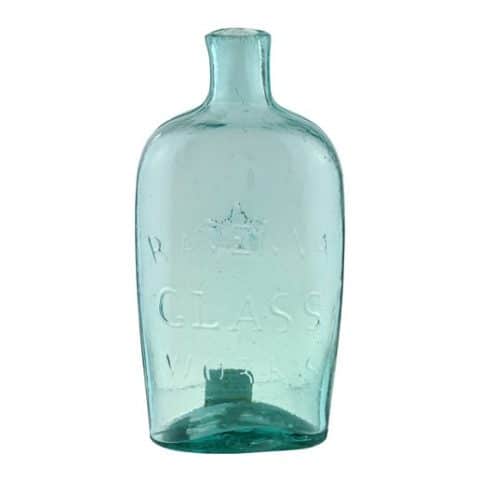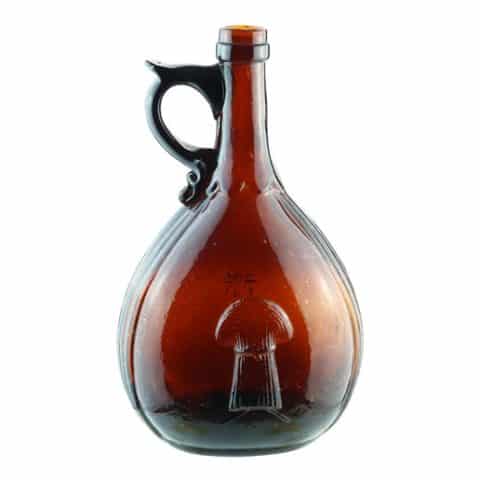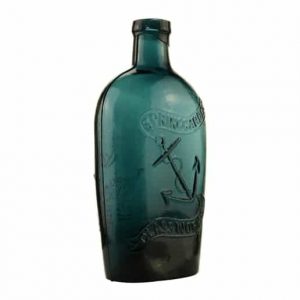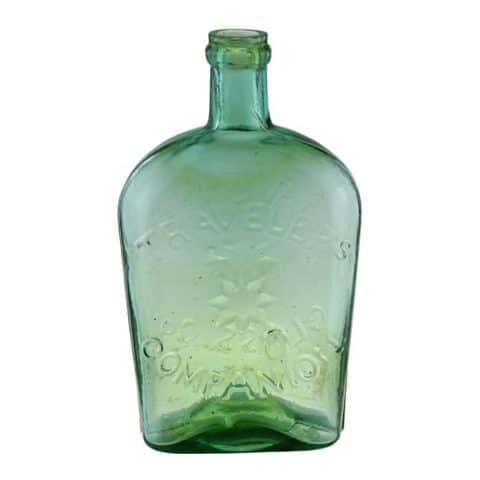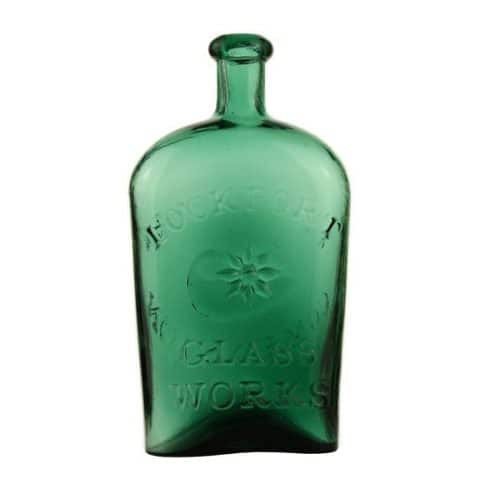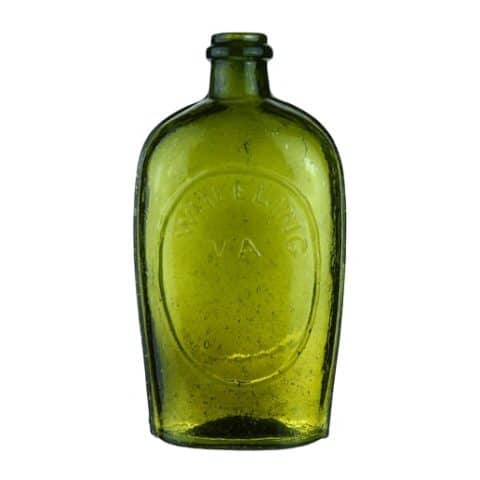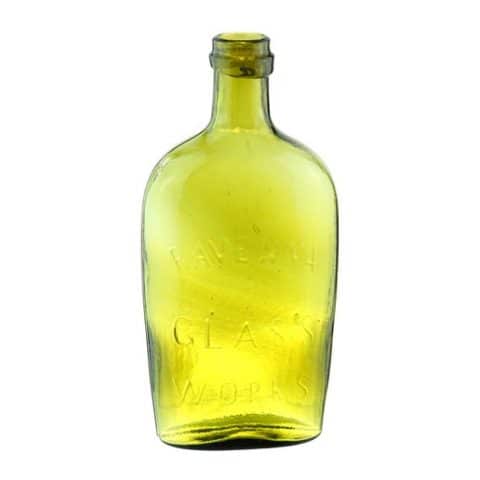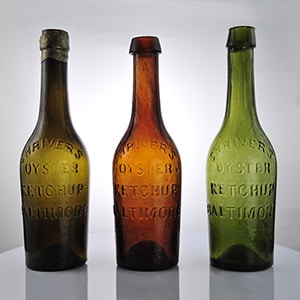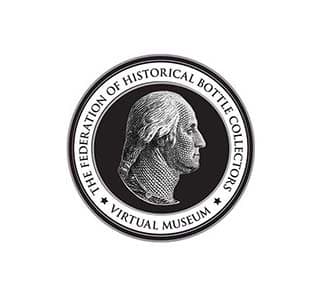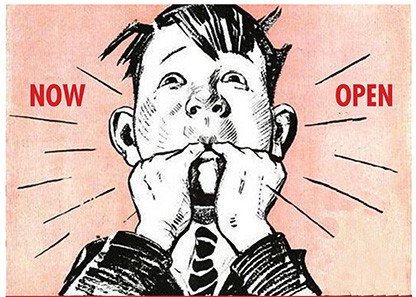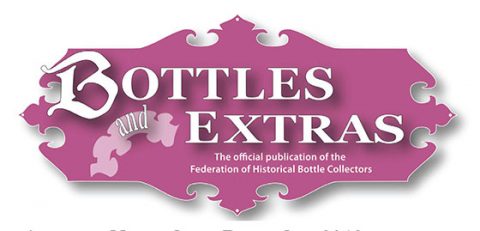GV-5 “Success To The Railroad” and Horse and Cart Flask
GV – 5
“Success To The Railroad” and Horse and Cart
Historical Flask
Mount Vernon Glass Works, Vernon, New York
Dark Olive Green Pint
Provenance: Anonymous
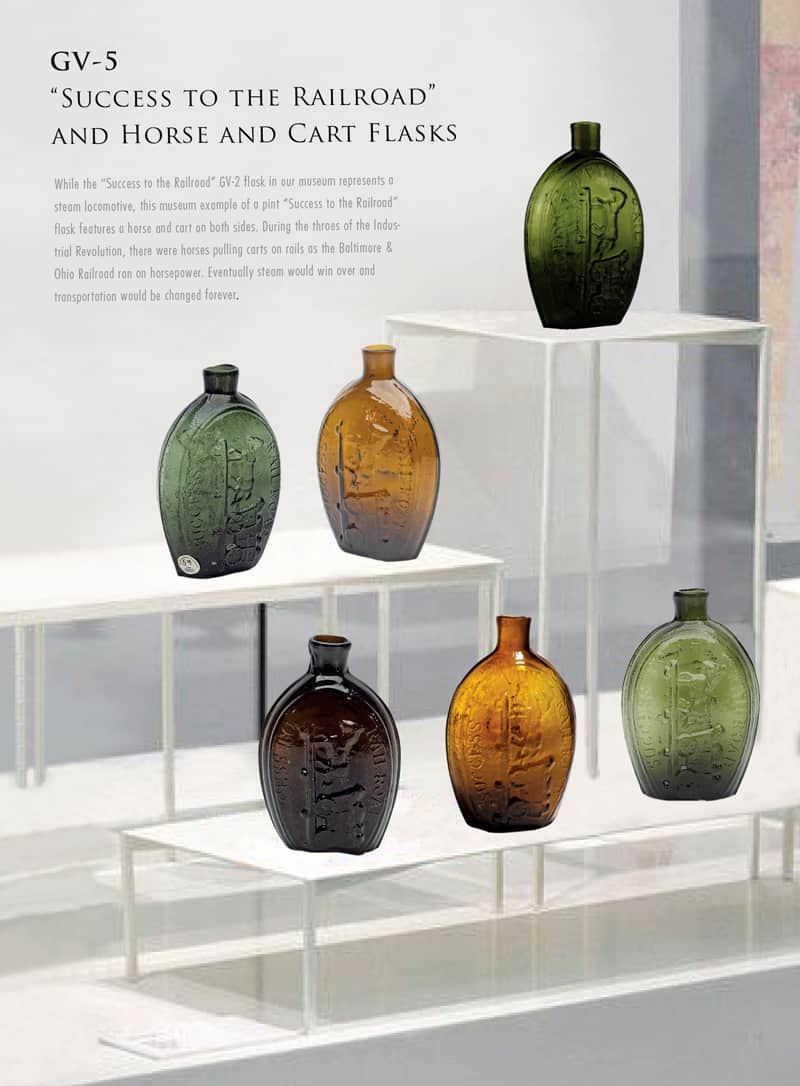
The railroad or railway, both the horse-and-cart type and the steam locomotive, inspired many early American flask designs. Of the fourteen railroad flasks charted, the slogan “Success to the Railroad” appears on seven.
The illustration segment below is from David C. Johnson’s lithograph of the “Granite Railway” operating out of Quincy, Massachusetts. The railway, which opened October 7, 1826, was the first in the United States. Horse-drawn carts carried the granite block for the Bunker Hill Monument 2-¾ miles from the quarry to Neponset River.
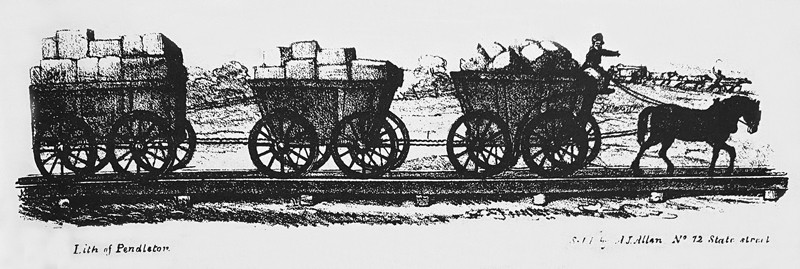
While the “Success to the Railroad” GV-2 flask in our museum pictures a “steam locomotive,” this museum example of a pint “Success to the Railroad” flask features a “horse and cart railroad” on both sides. During the throes of the Industrial Revolution, there were horses pulling carts on rails as the Baltimore & Ohio Railroad ran on horsepower. Eventually steam would win over and transportation would be changed forever.
Our GV-5 “Success to the Railroad” mold is interesting as it was produced somewhere in the late 1830s and 1840s by the Mount Vernon Glass Works in Vernon, New York. By the mid-1840s, the wood supply on lands owned or available to the glassworks was depleted. Glass pioneer Harry Hall White’s excavations on the factory site showed that when the Vernon Glassworks was moved to Saratoga, New York, in 1844 or 1845, the mold for the GV-5 was used at the Saratoga Mountain Glassworks to produce the “Horse and Cart Railroad” flasks. To date, it is not possible to tell which flask was made where.
See the museum example of a GV-3 Success to the Railroad flask.
See the museum example of a GV-4 Success to the Railroad flask.
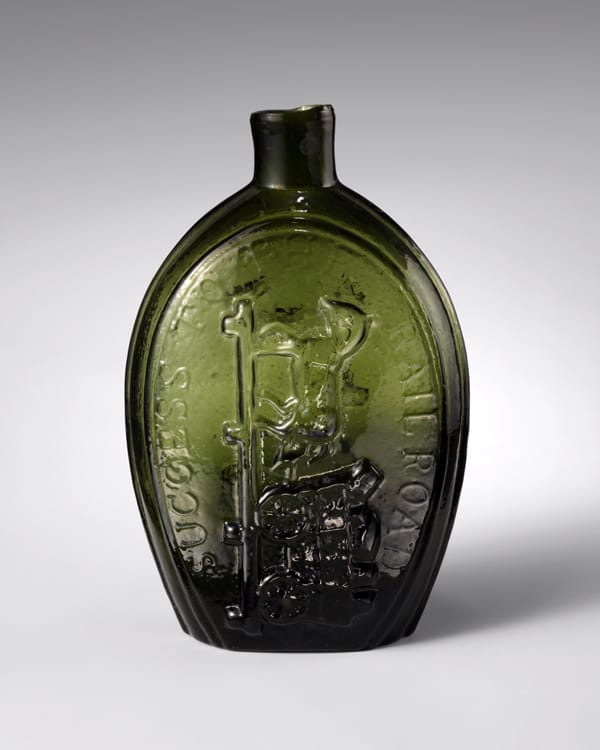
Mount Vernon Glass Company
The Mount Vernon Glass Company, located in Vernon, New York was one of the first glass factories to open in Oneida County. By 1809, four glassworks were licensed to operate in the country.
An act for incorporating the stockholders of the Mount Vernon Glass Company was passed by the New York State Legislature on February 17, 1810. The originating stockholders were Abraham Van Eps, William Root, Benjamin Pierson, Robert Richardson, Isaac Coe, Daniel Cook, Benjamin Hubble, David Pierson, Oliver Lewis, and other local businessmen from Utica, New York, and the surrounding area.
While the other three glassworks in the area concentrated on the production of window glass, Mount Vernon produced hollowware, ink, medicine, perfume, water, and other utilitarian bottles and flasks. As a result, the company competed with English producers as opposed to local companies. Products of this glassworks were primarily made from olive-green and aquamarine glass. Eventually, flint glass was added to their line, and blown three-mold and some pressed tableware were also produced.
The glassworks was sold to Charles Granger in 1823. In 1828, the incorporation expired and the operations were continued as C. Granger & Co. Charles operated the glass factory with various partners until 1841 when he sold three-quarters of the company to his brother Oscar Granger, Walter S. Todd, and Henry Chapman. The following year, Chapman sold his share to Oscar and Walter and in 1843, Charles sold them his remaining share. Between the years 1844 and 1845, Oscar Granger and Walter S. Todd moved the factory to Saratoga Springs, New York where they lasted until about 1846.
Known specimens from Mount Vernon include the GIII-2 Type 1 Decanter, our GV-5 “Success To The Railroad” – Horse and Cart flask, the GIII-11 Cornucopia-Urn flask, the GI-88, and 89 Lafayette-Masonic flasks, and the GVII-1 “North Bend”-“Tippecanoe” figural cabin and GVII-2 “Tippecanoe” cabin bottles to name a few.
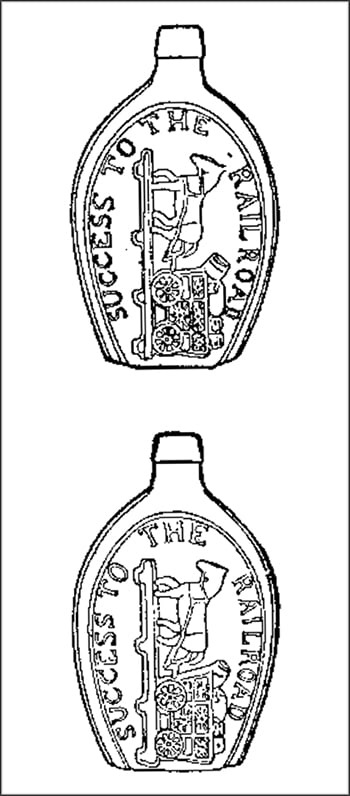
When looking at the designs within horseshoe oval panels on both sides of our GV-5 “Success to the Railroad” flask, there is an embossed horse pulling a cart toward the flask lip with an embossed rail beneath the horse and cart. There are minor typographical differences on both flask sides with the placement of the embossed ‘SUCCESS TO THE RAILROAD’ copy which appears in a horseshoe shape. A horseshoe ribbing surrounds the pictorial to create the oval panel.
The pint flask has a plain lip, broad sloping collar, and a pontil mark. The flask edges have three verticle ribs with a heavy medial rib.
You can find this flask in golden amber, amber, olive amber, clear dark olive green, and dark olive green (black) which are considered common. Clear green, emerald green, emerald moss green, clear dark green, clear green (slight olive tint), dark green, and dark yellow-green are considered comparatively scarce.
This GV-5 “Success to the Railroad – Horse and cart flask was reproduced a number of decades ago. There are slight differences in the mold used for the reproduction, the distinctive variation being that the horses’ mane shows distinctly, the hairs being perpendicular.
Primary Image: GV-5 “Success to the Railroad” and Horse and Cart flask imaged on location by the FOHBC Virtual Museum midwest studio led by Alan DeMaison.
Support: Reference to American Bottles and Flasks and Their Ancestry by Helen McKearin and Kenneth M. Wilson, Crown Publishers Inc., New York, 1978.
Read More: Success to the Railroad – The Baltimore & Ohio Railroad Museum
Read More: Mt. Vernon Glassworks Project by Richard Strunk, Bottles and Extras, November-December 2016
Secondary Images: Auction Lot 60: “Success To The Railroad” And Horse And Cart Historical Flask, Mount Vernon Glass Works, Vernon, New York, 1830-1850. Medium forest green, sheared mouth – pontil scar, pint. GV-5. One of the finest examples of its kind. Superior mold impression. Outstanding color. Attractive bubbles and crudity. Fine condition. Ex Orin Summerville collection, ex Robert Mebane collection. – Norman Heckler, Norman C. Heckler & Company
Secondary Images: Auction Lot 65: “Success To The Railroad” Historical Flask, Mt. Vernon Glass Works, Mt. Vernon, New York, 1830-1850. Deep olive amber, sheared mouth – pontil scar, pint; (minor exterior high point wear). GV-5 Very crude and heavy. Fine condition. – Norman Heckler, Norman C. Heckler & Company
Support Images: Auction Lot 15: “Success To The Railroad” And Horse And Cart Historical Flask, Mount Vernon Glass Works, Vernon, New York, 1830-1844. Bright yellowish amber, sheared mouth – pontil scar, pint; (light exterior high point wear). GV-5 A heavy flask with thick glass. Beautiful color. Fine condition. – Norman Heckler, Norman C. Heckler & Company, Auction #170
Support Images: Auction Lot 150: GV-5 HORSE PULLING CART – SAME PICTORIAL / HISTORICAL FLASK, medium bright yellow amber, pint, embossed “SUCCESS TO THE RAILROAD” on each side, plain mouth, rough pontil mark. One side flattened with a crude impression. Saratoga (Mt. Pleasant) and Mt. Vernon, New York. 1825-1850. 6 3/4″ H. Undamaged with only very minor high-point wear. Small stone with light surface bruise to one side, as made. Literature: McKearin/Wilson – American Bottles & Flasks, p. 603. Provenance: From the estate collection of Russell and Doris Evitt, Jackson, California – Jeffrey Evans, Jeffrey S. Evans & Assoc.
Support Images: Auction Lot 45: “Success To The Railroad” And Horse And Cart Historical Flask, Mount Vernon Glassworks, Vernon, New York, 1840-1860. Forest green, sheared mouth – tubular pontil scar, pint; (exterior high point wear). GV-5 Beautiful color, good embossing, millions of tiny bubbles. Ex George S. McKearin collection. – Norman Heckler, Norman C. Heckler & Company, Auction #99
Support Image: David C. Johnson’s lithograph of the “Granite Railway” – The American Antiquarian Society, Worcester, Massachusetts.
Support Image: Flask, 1835-1840, Mount Vernon Glass Works, Medium: Free-blown molded green glass, Dimensions: H. 6 3/4 in, Bequest of Constance R. Brown, 1939, Accession Number: 40.150.33, Metropolitan Museum of Art, New York, N.Y.
Join the FOHBC: The Virtual Museum is a project of the Federation of Historical Bottle Collectors (FOHBC). To become a member.

